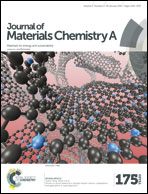Highly efficient and stable quasi-solid-state quantum dot-sensitized solar cells based on a superabsorbent polyelectrolyte†
Abstract
Limited by the volatilization and leakage of liquid electrolytes, the long-term stability of liquid-junction quantum dot sensitized solar cells (QDSCs) remains a main challenge for the application of QDSCs. Herein, a polyelectrolyte with superior water-absorbing and water-holding capacity, sodium polyacrylate (PAAS), was attempted to gelate conventional aqueous polysulfide electrolytes to construct quasi-solid-state QDSCs. PAAS gel electrolytes have a comparable conductivity with liquid polysulfide electrolytes. Meanwhile, the PAAS gel could penetrate readily into the framework of mesoporous TiO2 film electrodes due to the strong coordination ability of carboxylate groups on PAAS polymer chains with metal ions. Benefited from the high conductivity of the PAAS gel and its perfect contact with the TiO2 surface, an impressive photovoltaic performance with a power conversion efficiency of 8.54% in one full sunlight, which is among the best performance for QDSCs, was achieved for CdSeTe QDSCs. Furthermore, the light-soaking stability of the resulting cell devices is significantly improved in comparison with that of the conventional aqueous polysulfide electrolyte based ones.


 Please wait while we load your content...
Please wait while we load your content...